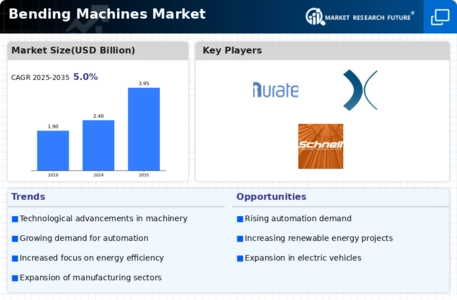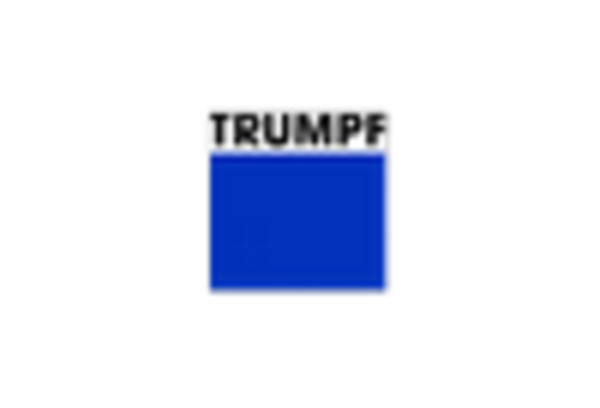Increasing Focus on Customization
Customization is becoming a key driver in the Bending Machines Market, as manufacturers seek to meet the specific needs of diverse industries. The ability to produce tailored components with varying specifications is increasingly important in sectors such as aerospace, construction, and furniture manufacturing. As clients demand unique designs and functionalities, bending machine manufacturers are adapting their offerings to provide flexible solutions. This trend is likely to lead to an increase in the production of specialized bending machines that can accommodate a wide range of materials and bending processes. Consequently, the Bending Machines Market is expected to witness growth as companies invest in developing machines that offer enhanced customization capabilities.
Growth in Automotive Manufacturing
The automotive manufacturing sector significantly impacts the Bending Machines Market, as these machines are crucial for producing various components such as frames, chassis, and exhaust systems. With the automotive industry projected to grow at a rate of around 4% annually, the demand for bending machines is likely to increase correspondingly. Manufacturers are investing in advanced bending technologies to improve production efficiency and reduce waste. The shift towards electric vehicles also presents new opportunities for the Bending Machines Market, as the production of lightweight materials becomes essential. Consequently, bending machines that can handle diverse materials and complex geometries are in high demand, driving innovation and growth within the industry.
Rising Demand in Construction Sector
The Bending Machines Market is experiencing a notable surge in demand, particularly driven by the construction sector. As urbanization accelerates, the need for bending machines to fabricate steel and other materials for construction projects becomes increasingly critical. In recent years, the construction industry has seen a compound annual growth rate of approximately 5.5%, which directly influences the demand for bending machines. These machines are essential for producing rebar and other structural components, thereby facilitating the construction of buildings, bridges, and infrastructure. The increasing complexity of construction designs necessitates advanced bending technologies, which further propels the Bending Machines Market. As a result, manufacturers are focusing on developing machines that offer enhanced precision and efficiency to meet the evolving needs of the construction sector.
Sustainability and Eco-Friendly Practices
Sustainability is emerging as a significant driver in the Bending Machines Market, as manufacturers and consumers alike prioritize eco-friendly practices. The push for sustainable manufacturing processes has led to an increased demand for bending machines that minimize waste and energy consumption. Companies are exploring ways to incorporate recyclable materials and reduce their carbon footprint, which influences their choice of bending technologies. The adoption of energy-efficient machines not only aligns with environmental goals but also offers cost savings in the long run. As regulations surrounding sustainability become more stringent, the Bending Machines Market is likely to evolve, with manufacturers focusing on developing machines that meet these new standards while maintaining high performance.
Technological Innovations in Bending Machines
Technological advancements play a pivotal role in shaping the Bending Machines Market. Innovations such as CNC (Computer Numerical Control) technology and automation are revolutionizing the way bending machines operate. These technologies enhance precision, reduce human error, and increase production speed, making them indispensable in various manufacturing processes. The integration of smart technologies, such as IoT (Internet of Things), allows for real-time monitoring and predictive maintenance, further optimizing machine performance. As manufacturers seek to improve efficiency and reduce operational costs, the demand for technologically advanced bending machines is expected to rise. This trend not only boosts the Bending Machines Market but also encourages manufacturers to invest in research and development to stay competitive.


















Leave a Comment